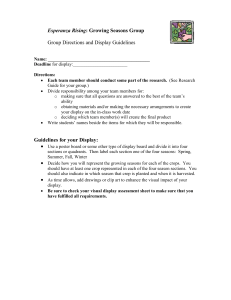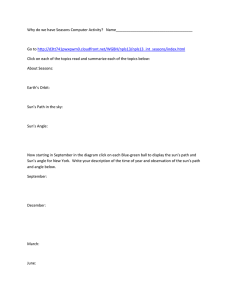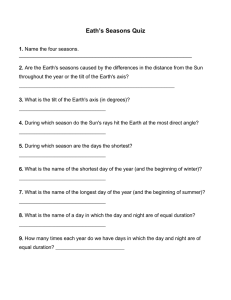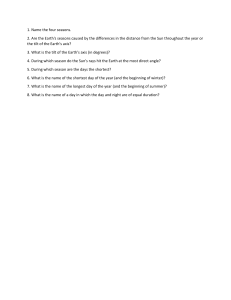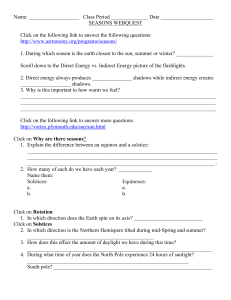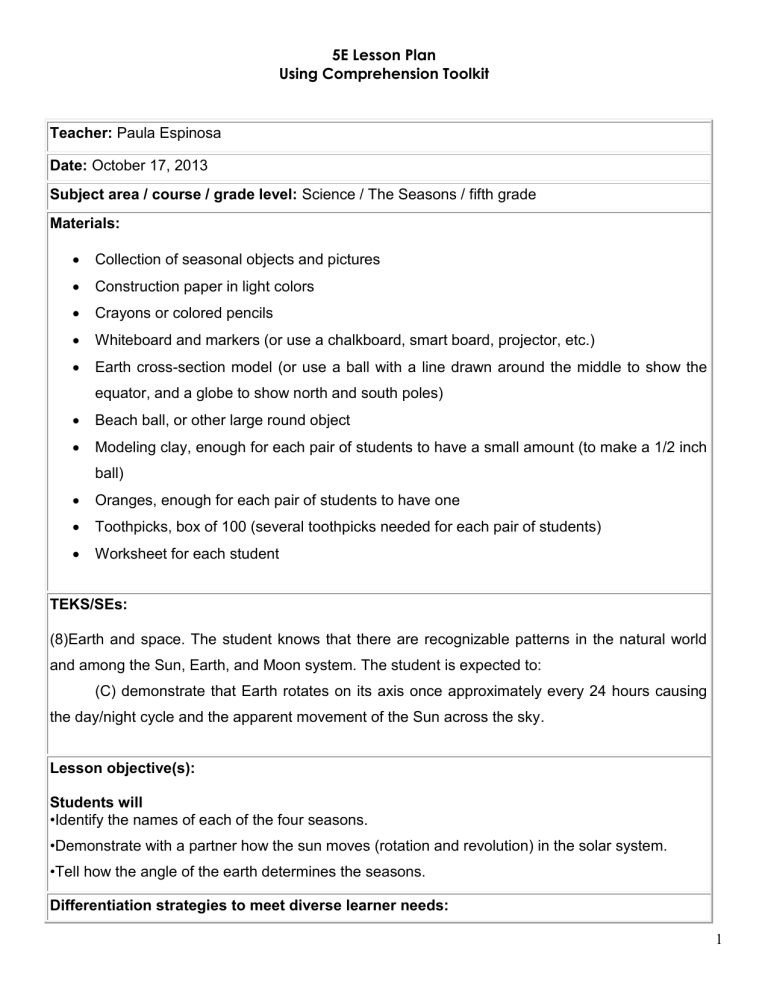
5E Lesson Plan Using Comprehension Toolkit Teacher: Paula Espinosa Date: October 17, 2013 Subject area / course / grade level: Science / The Seasons / fifth grade Materials: Collection of seasonal objects and pictures Construction paper in light colors Crayons or colored pencils Whiteboard and markers (or use a chalkboard, smart board, projector, etc.) Earth cross-section model (or use a ball with a line drawn around the middle to show the equator, and a globe to show north and south poles) Beach ball, or other large round object Modeling clay, enough for each pair of students to have a small amount (to make a 1/2 inch ball) Oranges, enough for each pair of students to have one Toothpicks, box of 100 (several toothpicks needed for each pair of students) Worksheet for each student TEKS/SEs: (8)Earth and space. The student knows that there are recognizable patterns in the natural world and among the Sun, Earth, and Moon system. The student is expected to: (C) demonstrate that Earth rotates on its axis once approximately every 24 hours causing the day/night cycle and the apparent movement of the Sun across the sky. Lesson objective(s): Students will •Identify the names of each of the four seasons. •Demonstrate with a partner how the sun moves (rotation and revolution) in the solar system. •Tell how the angle of the earth determines the seasons. Differentiation strategies to meet diverse learner needs: 1 5E Lesson Plan Using Comprehension Toolkit Students will be working in groups/pairs to help each other. Teacher will ask questions to have students repeat theory seen in class Students will have concrete and pictorial material in class to help them to understand the concepts. Teacher will project a picture that will help students to visualize and comprehend the topic. ENGAGEMENT Teacher will have collected previously to class a variety of seasonal objects and pictures that show the four different seasons. Teacher can ask students to bring from home any objects related to the different weather we have during the year, without saying the word season. Teacher will divide the class into groups of 3-4 students. Each group will receive a set of objects from the teacher; each set of objects should have between 10-20 objects such as magazine pictures (beach scenes, snow scenes) fake fall leaves, winter hat, gloves, flower seeds, umbrellas, snow flacks, Christmas items Teacher will ask the students to sort the objects they have at their group, teacher will explain to students that there are many ways to sort the objects, and they must decide as a group how to sort them. After each group is finished, talk with the class about the different ways the objects were sorted. Did any group choose to sort their items by the four seasons? Explain that they will be learning more about what each season is and why we have seasons. EXPLORATION Teacher will write on the boar the word ‘winter’, and have students come up with words to describe it. Teacher will do the same for 'summer,' and then for spring and fall. Once there is a list of words describing each season, teacher will hand out pieces of construction paper to each student. Each student should choose a season, and draw a picture of what the weather looks like, using crayons or colored pencils. After they have finished their picture, have the students turn the construction paper over and write 2-3 sentences about the season they chose. Remind them to use descriptive words, like those written on the board. 2 5E Lesson Plan Using Comprehension Toolkit EXPLANATION Teacher will use the cross-section model of the earth; point out the equator line and ask them if they know what that is. Now, point out the north and south poles. Tell the class that we live closer to the North Pole. Explain that Earth spins around in a circle (called rotation) while making a path (also called an orbit) around the sun. One complete orbit around the sun is called a revolution. One revolution is a year. One rotation is a day. Teacher will display the worksheet (page 5) on a projector screen so everyone can see it. Explain that the earth actually revolves around the sun at a tilt, or angle. This is called its rotational axis. Hold the foam model; point out the equator again, then tilt the model so that it is at an angle (meaning the north pole does not point straight up). Ask for a volunteer to come up and hold the flash light. Explain that the flash light represents the sun and the foam model is the earth. Still holding the foam model at an angle, slowly walk around the sun, completing one revolution. How does the rotational axis determine the seasons? When the north pole is tilted away from the sun, it is winter in North America. When the south pole is tilted away from the sun, it is summer! The inbetween seasons (spring and fall) are when the earth gets just about the same amount of sunlight on the south and north poles. When it is summer on one part of the globe, it is winter on the other part. The equator is always the warmest part on earth because it is closest to the sun no matter what the angle of the earth is. After finishing explaining why we have seasons teacher will ask a few questions to make sure everybody understood the concept. What season do they have in the south when north is in summer? Where is the equator? What place in earth is the closest to the sun? What is a rotation? What is a revolution? Teacher will ask for a volunteer to explain in her/his own words why we have seasons Teacher will make sure all the students understood the concept about the seasons. Students will receive a worksheet to complete individually. 3 5E Lesson Plan Using Comprehension Toolkit ELABORATION Remind students how it looked when you held the earth model and walked around making a single revolution. Tell students that the sun always rotates while it is revolving. Students will get in pairs; each pair will have a small piece of clay, a toothpick, and a small orange. Teacher will model to students what they will do afterwards. Take a small piece of clay (about half an inch in diameter) and insert a toothpick in the center, so you can spin it between your fingers. Spinning in a circle like this is what the earth is doing constantly! In order to make one rotation a day, the earth must move at speeds of 1,000 mph, while at the same time travel through space (orbiting the sun) at speeds of 67,000 mph! Now, have students do the same, let them experience how the clay model of the earth is able to move around the sun (the orange) up close. Walk around making sure that each group understands that the earth moves at an angle, and they hold their toothpicks at an angle instead of straight up and down. If students understand this concept well, you may have them also spin the orange slowly, since our sun does rotate (though not at the same speed of earth). EVALUATION When students are finished creating their clay-and-orange model of the earth's movement around the sun, have each student get out their drawing of a season that they worked on before. On the back, have each student write about what makes seasons and why the weather feels the way it does during the season they chose. Point out the words 'orbit,' 'revolution,' and 'rotational axis' on the board, to help students write their sentences. Each student should turn in their drawing when finished, so teacher can read what they wrote and check for understanding. 4 5E Lesson Plan Using Comprehension Toolkit 5 5E Lesson Plan Using Comprehension Toolkit 6
